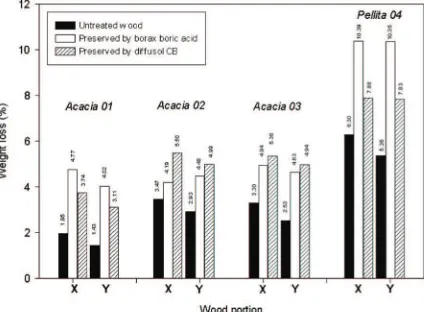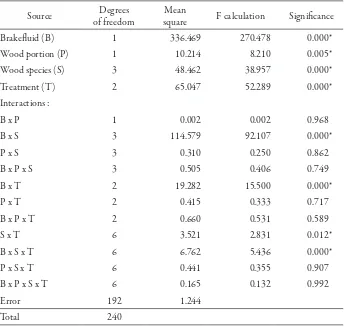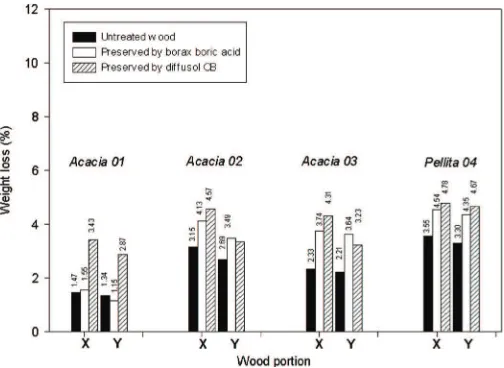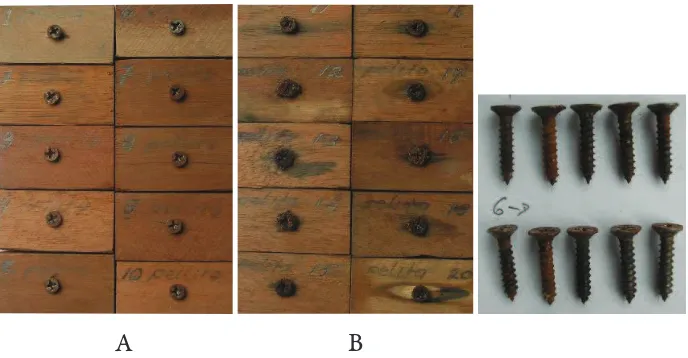91-99
Krisdianto Sugiyanto1,2,3 and Didik A. Sudika1
ABSTRACT
he rigidity and irmness of wooden construction and furniture those are joined by metal screws depend on corrosion rate of these metals. his paper examines the weight-loss percentage of metal screws used in wood samples that have been treated with water-borne preservative (i.e. 3% borax boric acid and 3% difusol CB) and concurrently investigates the efect of brake luid on preventing metal corrosion. Wood samples tested included three acacia and one eucalypts wood species which were grouped into sapwood and heartwood containing samples. Wood samples fastened with metal screws were freely suspended in glass jars that contained 25 ml of sulphuric acid (H2SO4) to keep the humidity rate above 90%. Ater 12 months, the metal screws lost their weight due to the corrosion brought about by the related factors either in separate individual or in combination, which comprised brake and luid-dipping, wood species, wood portion (sapwood and heartwood), kinds of preservatives used. Corrosion rates of metal screws fastened in eucalypts wood sample as indicated by the screw-weight loss (i.e. 5.8%) was more severe than that fastened in acacia wood. Furthermore, corrosion rate of metal screws as ixed irmly in sapwood sample proceeded faster than that in heartwood. his might be caused by the higher moisture content in sapwood. On the other hand, corrosion rate of the screws as fastened in waterborne-preservative-treated wood samples was greater than that in non-preserved wood due to electrokinetic characteristics and ionic potential exhibited by the preservative thereby intensifying the screw-corrosion process. Meanwhile, less severe corrosion was observed and recorded on the screws pre-dipped in brake luid compared to those on the non-dipped screws.
Keywords: corrosion, wood species, preservation, brake-luid dipping
I. INTRODUCTION
In timber construction and wooden furniture manufacturing, metal materials, such as screws and nails, are frequently used as joint components. he use of metal components oten creates problems due to the corrosion, as the corroded metals become lost in strength and easily break when used in joinery. Metal corrosion is an electrochemical process that occurs when metal is exposed to moist and acid condition. he rigidity and irmness of wooden construction and furniture that are joined by metal screws depend on the corrosion process of the metal material in the wood itself (Baker, 1987; Aytekin, 2008).
1 Center for Forest Products Research and Development, Jl. Gunung Batu 5, Bogor 16000, Indonesia 2 School of Graduate Studies, he University of Melbourne, Australia
Factors that may enhance metal corrosion in wood include wood species, presence of external corrosive contaminants, and preservative treatment of wood (Baker, 1987: 1992). Wood species may bring about metal corrosion rates as chemical content in wood creates acidity and humid environment for metal screws. Most wood species are slightly acidic, with a pH of 4 to 6, while some other wood species contain greater organic acid which causes the lowering of pH.
One of the external contaminants that may induce corrosion rate is water condensation that happens when timber construction is used in humid conditions. For example, excessive steam condensed in the wooden roof that covers steam chamber. he condensed steam will release heat, which further warms up the moist air inside the structure of wooden materials together also with their metal joineries thereby catalysing the metal-corrosion rate (Baker, 1987).
In general, the efect of preservative treated wood in corrosion rates varies accordingly. Wood that has been treated with oil-based preservatives sufers less corrosion than that with water-borne preservatives (Baker, 1992). Heavy-oil-based wood preservatives do not only preserve the wood but also coat the surface of the metal fasteners, which consequently reduce the corrosion rates. On the other hand, water-borne preservatives which mainly contain metal elements, particularly copper enhance the electrochemical process of metal corrosion because copper ions that penetrate the wood cells and then become saturated inside inlict diferential potential of electronegative ion inside the fasteners (Baker, 1987).
he relationship between metal corrosion rate and the use of preservative wood has been studied by several researchers. Baechler (1934) studied the corrosion of wire nails in wood treated with zinc-chloride and exposed to moderately humid conditions in Madison. He stated that the corrosion of wire nails in zinc-chloride treated wood was signiicant, and some eforts to protect the wood, such as painting and sodium chlorate addition were inefective to reduce the corrosion rates.
Extensive study was carried out in 1973 to obtain some information on the corrosion rates of various metals and metal coatings in wood treated with water-borne preservatives. In preliminary research, Kadir and Barly (1974) noted that metal corrosion in wood treated with water-based preservative was tolerable. However, such experiments were carried out with limited number of samples of sotwood species, i.e. tusam (Pinus
merkusii Jungh et de Vr.). Meanwhile, the information on metal corrosion of hardwood
species especially fast growing species had not been identiied.
in wood samples treated with the so-called borax boric acid and difusol copper boron (CB). Wood species studied included three acacia wood species and one eucalypts species classiied as fast growing species. he samples were grouped into sapwood and heartwood-containing samples. To look into the efectiveness of brake luid in preventing metal corrosion, some screws were dipped into the brake luid prior to the test.
II. MATERIALS AND METHODS
he hardwood species studied included acacia 01 (Acacia crassicarpa A.Cunn.), acacia 02 (Acacia auriculiformis A.Cunn.),acacia 03 (Acacia aulacocarpa A.Cunn.) and pellita 04 (Eucalyptus pellita F.Muell.) that were taken from plantation forest in Riau, Indonesia. he wood samples were cut and divided into sapwood and heartwood containing samples to the size measuring 50 mm x 25 mm x 15 mm. Air dried wood samples were selected accordingly so that the grain direction was tangentially angled to the 50-mm face. For the experiment with water-borne preservative, ten blocks were treated using 3% borax boric acid and 3% of difusol CB each. Air dried wood samples were initially pre-vacuumed for 30 minutes and then compressed for 30 minutes.
Prior to the insertion into the treated and untreated wood samples, stainless steel screws of 5/8 inch NASA, made in China were cleaned and allowed to dry before being weighed. Each screw was then fastened into a separate piece of wood to prevent cross contamination between metal screws. To see the efect of brake liquid in preventing metal corrosion, steel screws were pre-dipped into Preston Dot-3 brake luid.
To keep the humidity above 90%, the samples with the metal screws inside were then tested according to those explained by G. Schikorr (Broese van Groenou et al., 1951) then modiied by Kadir and Barly (1974). Wooden samples were freely hanged with nylon string in the glass jars that contained 25 ml of 2N-sulphuric acid (H2SO4) solutions and further let for 12 months (Figure 1).
Ater 12 months, metal screws were then removed in such a way to minimize damage to the metal screws, and then soaked into HCl solution to clean them up from the excess of corrosion. Before weighing, the screws were cleaned using ethanol and acetone. he metal corrosion rates were examined based on the percentage of weight loss in metal screw during the corrosion test.
Nylon string
Metal screw
Wood samples Glass Jar
Sulphuric acid
Figure 1. Glass jar containing screwed wood samples
III. RESULTS AND DISCUSSIONS
It turns out that percentage of weight loss varies with wood species, diferent wood portions and kinds of preservatives (Figure 2). he highest percentage of weight loss occurred to metal screws that had been fastened in pellita 04 wood samples, which recorded a weight loss of 10.4%. Meanwhile, the metal fastened in acacia wood samples (01, 02 and 03) lost only 1.6 to 5.5% of their weight. his implies that the corrosion rate is greater in pellita wood than that in acacia wood samples. he higher corrosion rate in eucalypts (pellita 04) wood was presumably caused by more acidic condition in pellita wood samples. Krisdianto et al. (2006) reported that the percentages of hemicellulose and lignin in pellita wood are slightly higher than that in acacia wood sample; as a result, the more acetyl groups in pellita wood created lower pH condition than those in acacia wood samples.
Figure 2 also shows that the percentage of weight loss of metal screws that were turned inwards the heartwood is less than those in sapwood samples. In other words, metal screws fastened in sapwood suffered corrosion more severely than those in heartwood. Compared to heartwood, sapwood contains more alive wood cells (e.g. parenchyma cells) that function as water and nutrient transport, food reserves, and other physiological activities (Butterield, 1993), thereby providing more moisture content inside which further creates more humid condition and hence enhances corrosion rate. he use of water-borne preservatives being borax boric acid and difusol CB on wood samples signiicantly increases the percentage of weight loss of the screw. Analysis of variance (Table 1) shows that the weight-loss percentage of metal screws fastened in preserved wood samples is higher than that in unpreserved wood samples. In the preserved wood samples, the deposit of copper ions as by-product of salt preservative increased electrical conductance of screws, thereby signiicantly intensifying their corrosion rate.
Table 1. Analysis of variance on the weight loss of metal screws fastened in the preserved wood
Source Degrees
of freedom
Mean
square F calculation Signiicance
Brakeluid (B) 1 336.469 270.478 0.000*
Wood portion (P) 1 10.214 8.210 0.005*
Wood species (S) 3 48.462 38.957 0.000*
Treatment (T) 2 65.047 52.289 0.000*
Interactions :
B x P 1 0.002 0.002 0.968
B x S 3 114.579 92.107 0.000*
P x S 3 0.310 0.250 0.862
B x P x S 3 0.505 0.406 0.749
B x T 2 19.282 15.500 0.000*
P x T 2 0.415 0.333 0.717
B x P x T 2 0.660 0.531 0.589
S x T 6 3.521 2.831 0.012*
B x S x T 6 6.762 5.436 0.000*
P x S x T 6 0.441 0.355 0.907
B x P x S x T 6 0.165 0.132 0.992
Error 192 1.244
Total 240
Remarks * = signiicance at 5% level
Figure 3. Weight loss (%) of metal screws pre-dipped in brake luid Remarks: X = sapwood, Y = heartwood
In general, the percentage of weight loss occurred in metal screws which were pre-dipped into the brake luid (Figure 3) was 24 – 43% less than that of the non-pre-dipped screws (Figure 2). he percentage of weight loss of pre-dipped metal screws in average is 1.9% for acacia-01, 3.6% for acacia-02, 3.2% for acacia-03 and 4.2% in pellita-04. Based on the wood treatment, the weight loss is 2.5% in untreated wood, 3.3% in borax boric-acid-treated wood and 3.9% in difusol-CB-treated wood (Figure 3). Meanwhile, the corresponding weight loss for the non-dipped metal screws were consecutively 3.4%, 5.9%, and 5.4% in untreated wood, borax boric-acid and difusol CB wood treated samples (Figure 2). Analysis of variance in Table 1 shows signiicant diferences at 5% level in the weight losses of the metal screw, between the non-dipping and the brake-luid dipped screws.
Weight-loss patterns of pre-dipped metal screw (Figure 3) were similar to those of non-dipped metal screw weight loss (Figure 2). In general, the corrosion rates of metal screw fastened in pellita 04 wood were 34 – 46% higher than those in acacia wood samples. Further, the corrosion rates of metal screws in sapwood were 12 – 28% higher in average than those in heartwood. Still related, the corrosion rates of metal screws fastened in preservative treated wood samples were higher than those non-preserved wood samples (Figures 2 and 3).
untreated, borax boric-acid and difusol CB (T). Less severe corrosion occurred in metal screws pre-dipped in brake luid. he brake luid which is inherently glycol ether based oil, protected metal screws from corrosion by blocking moisture from wood samples to contact the screw surface. However, excessive brake luid created oil marks in the area surrounding the metal screw (Figure 4).
Analysis of variance on the weight loss of metal screws (Table 1) also reveals that signiicant efect at 5% level was inlicted not only by individual factors, i.e. brake-luid treatment (B), wood species (S), wood portion (P) and kinds of preservatives as used (T), but also by interaction between two as well as three of those four factors (B, S, P, and T), i.e. B x S, B x T, S x T, and P x S x T. hose signiicant interaction efects implied that the efect of each of those four factors separately might behave diferently from those in combination; and these occurring phenomena are essential and should be taken into thorough consideration.
A
B
Figure 4. Non-break-luid-dipped metal screw (A) and oil marks of break-luid-dipped metal screw in the surrounding area (B)
IV. CONCLUSION
REFERENCES
Aytekin, A. 2008. Determination of screw and nail withdrawal resistance of some important wood species. International Journal of Molecular Sciences 9: 626-637. Baechler, R.H. 1934. Corrosion of metal fastenings in zinc-chloride-treated wood.
Industrial Engineering Chemistry 26(12): 1336-1338.
Baker, A.J. 1987. Corrosion of metals in preservative-treated wood. In: Hamel Margaret (Ed.) Wood protection techniques and the use of treated wood in construction: Proceeding 47358. Forest Products Society, Madison, USA, pp. 99-101.
Baker, A.J. 1992. Corrosion of nails in CCA and ACA treated wood in two environments. Forest Products Journal 42(9): 39-41.
Broese van Groenou, H., H.W.L. Rischen and J. van den Berge. 1951. Wood preservation during the last 50 years. A.W. Sijthof ’s Uitgeversmaatschappij N.V. Leiden. 318p. Butterield, B.G. 1993. he structure of wood: an overview. In: Walker, J.C.F. (Ed.)
Primary Wood Processing, Principles and Practice. Chapman and Hall, London. Kadir, K. and Barly. 1974. Notes on the corrosive action of some waterborne wood
preservatives. Research note No. 6. Forest Products Research Insitute, Bogor, Indonesia.
Krisdianto, G. Pari, G. Sumarni and J. Malik. 2006. Sifat dasar kayu Acacia crassicarpa dan
Euclayptus pellita. Laporan Hasil Penelitian. Pusat Penelitian dan Pengembangan



